- 1Tianjin Branch of CNOOC (China), Tianjin, China
- 2School of Geosciences, Yangtze University, Wuhan, China
The high-quality reservoirs in the Shahejie Formation of the Laizhou Bay Sag, Bohai Bay Basin, Eastern China formed in the Paleogene saline lacustrine environment and show complex diagenetic evolutionary processes caused by alternating acid and alkaline fluids. Through observations under an optical microscope and a scanning electron microscope, casting thin sections, and plane porosity measurements, this study investigated the diagenesis differences in the third member of the Shahejie Formation (Es3 Member) in the root and central portions of a fan delta in the E12 structure in the eastern Laizhou Bay Sag, respectively. The Es3 reservoirs in the well A-1 which have no any hydrocarbon shows, are relatively tight, and have high argillaceous content, poor particle sorting, strong mechanical compaction, and intense carbonate cementation due to long-term activities of alkaline fluids. Moreover, they were not altered by organic acid due to the far lateral distance from source rocks. By contrast, the Es3 reservoirs in the well A-2 with hydrocarbon accumulations, contain an anomalously high porosity zone due to the superimposition of five episodes of alternate acid-alkaline fluids. The diagenetic fluids controlling the formation of the high-quality Es3 reservoirs are sourced from connate saline pore waters, gypsum dehydration, salt diapir, and organic acid. Moreover, chlorite coats in the reservoirs in the well A-2 inhibit secondary overgrowth of quartz and, thus, protect primary pores. The chlorite coats and alkaline-acid dissolution alterations are critical to the formation of the high-quality reservoirs in well A-2.
Introduction
Secondary pores by diagenesis are crucial to the formation of moderate to deep high-quality reservoirs in sedimentary basins (Bloch et al., 2002). As revealed by many cases, anomalously high porosity zones that deviate from normal compaction trend are frequently visible at one or more depth intervals from the profiles of depth vs porosity of many oilfields (Volkmar and Mc Donald, 1979; Su et al., 2018a; Vafaie et al., 2021). In addition to disequilibrium compaction, secondary dissolution can create a large amount of extra reservoir space, and the resultant high-quality reservoirs are of great practical significance for predicting favorable hydrocarbon accumulation areas (Katz et al., 2021; Jiang et al., 2022; Wang et al., 2022). Numerous previous studies indicated that a number of fluids in sedimentary basins, including organic carboxylic acid and CO2 released from the thermal evolution of organic matter (Surdam et al., 1984), basinal hot fluids (Anna et al., 2009; Su et al., 2021a), meteoric freshwaters infiltrating downward (Ehrenberg, 1993), and deep mantle-derived CO2 (Su et al., 2018b), can cause reservoir dissolution.
In recent years, sec1osited in saline lacustrine settings (Su et al., 2021b), such as the Shahejie Formation in the Dongying Depression of the Bohai Bay Basin—a rifted lacustrine basin in eastern China (Wang et al., 2013; Li, 2017; Meng et al., 2017). Alkaline lakes were formed by the gradual salinization of lake water due to a semi-arid to arid climate, whose salt sources may originate from transgressions, an input of weathered ancient evaporites around lacustrine basins, or deep geothermal brine activities during basin rifting (Yuan et al., 2005). At present, the formation and controlling factors of favorable reservoirs in initially alkaline lacustrine sediments are not yet fully understood. In particular, the diagenetic fluids continuously change during fluid evolution, which creates a main challenge and area of focus to understand the control of high-quality reservoirs by an alternating acid and alkaline diagenetic environments.
Two wells have recently been drilled in the E12 structure in the Laizhou Bay Sag, which has a similar geological setting to the Dongying Depression. The two wells lie in the root and central portions of a fan delta in the Shahejie Formation. However, well testing has shown that they have significantly varying volumes of hydrocarbon accumulations. The previous study revealed that the differential hydrocarbon accumulation may be caused by the quality of reservoirs. Therefore, we collected cores from the Shahejie reservoirs in the two wells in the E12 structure, and systematically compared and analyzed reservoir diagenesis through microscopic observations. The main purpose is to explore the formation of high-quality reservoirs under the control of the diagenetic fluid evolution in a saline lacustrine basin and, thus, to provide a reference for the prediction of excellent reservoirs in other analogous petroliferous basins.
Geological setting
The Laizhou Bay Sag is located in the southern portion of the Meso-Cenozoic Bohai Bay Basin (in eastern China) with abundant petroleum resources. This area borders the Laibei uplift in the north and the Weibei uplift in the south and is bounded by the large-scale Tanlu strike-slip fault zones in the east, covering an area of approximately 1,780 km2 and appearing as a rhomboid. As a Cenozoic half-graben developing above the Mesozoic basement, the Laizhou Bay Sag is a dustpan-shaped sag that is faulted in the south and is overlapped in the north and contains a central uplift zone and three sub-sags in the northeast, north, and south (Xue et al., 2022; Figure 1A).
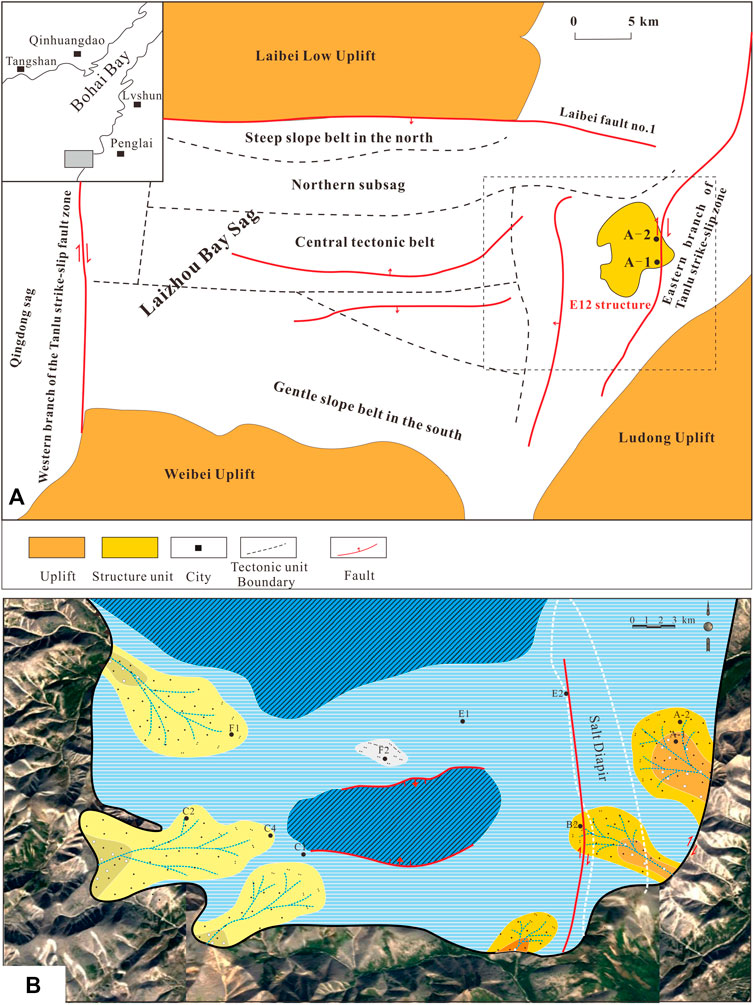
FIGURE 1. Regional geological location maps of the Laizhou Bay Sag and sub-structural units (A) and sedimentary facies during deposition of the Es3 Formation (B).
Tectonically, the Laizhou Bay Sag was formed by the comprehensive action of the individual and locally superimposed extensional and strike-slip stresses. Normal faults primarily developed in the sag during the early-middle rifting stages (Yang et al., 2021), while strike-slip faults dominated in the sag during the late rifting. The Cenozoic strata deposited in the sag include the Paleocene Kongdian Formation, the Shahejie Formation, the Oligocene Dongying Formation, the Neogene Guantao and Minghuazhen formations, and the Quaternary Pingyuan Formation (Niu et al., 2022). Among them, the Eocene Shahejie Formation contains the most important reservoir and source rock intervals of the Laizhou Bay Sag (Yang et al., 2021). The fourth member of the Shahejie Formation (the Es4 Member) was deposited in an arid to semi-arid climate. Meanwhile, medium-low water level saline lakes developed in this member, wherein large amounts of anhydrite and gypsum-bearing mudstones were deposited (Chen et al., 2019). The Es3 Member was mainly deposited in a transitioning climate from relatively arid to humid. During the deposition of Es3 Member, the water level of the Bohai Bay Basin increased, and the lake water gradually became less saline with an increase in the injected fresh water. As a result, dark mudstones were deposited in the deep lacustrine environment, and large-scale fan deltas and turbidite fan sedimentary systems developed at the margin of the Laizhou Bay Sag. During the deposition of the Neogene Guantao and Minghuazhen formations, salt arches formed in the Laizhou Bay Sag under the influence of the Tanlu strike-slip fault activity (Figure 1B). Furthermore, the salt diapirs penetrated into the north portion of the sag and their penetration depth decreased as the strike-slip weakened.
This study investigated the E12 structure, which lies in the southeast of Laizhou Bay Sag (Figure 1A). The drilling target in the study area mainly includes the fan delta sedimentary system that developed during the deposition of the Es3 Member (Figure 1B). Two exploration wells, A-1 and A-2, were drilled in the study area. Previous sedimentary facies analysis has shown that well A-1 mainly lies in the root of a fan delta while well A-2 is located in the central portion of a fan delta. High-quality reservoirs of the Es3 Member were only encountered in well A-2, indicate the differences in the development of high-quality reservoirs in the E12 structure.
Experiments and testing
A total of 75 sandstone core samples were collected from the Shahejie Formation reservoirs at exploration wells A-1 and A-2 in the E12 structure. Polished optical thin sections were prepared for microscopic petrological observations. Polarization microscopes Leica DMRP 551007 and Zeiss Imager A1 equipped with 4×, 10×, and 20× lenses were employed to identify the compositions of sandstone particles as well as the petrological and diagenetic characteristics, aiming to determine diagenetic minerals affecting porosity and permeability, and estimate the cement content and plane porosity. The methods proposed by Longiaru (1987) and Powers (1953) were used to determine the sorting and particle roundness of the sandstone samples. In addition, blue epoxy resin was added to several representative casting thin sections to prepare casting thin sections for the quantitative identification of pore types (e.g., primary intergranular pores and secondary dissolution pores) and plane porosity estimation. Some thin sections were stained with alizarin red and potassium ferricyanide solution to identify different types of carbonate cements in sandstones.
Some polished thin sections with sputtered carbon films were prepared. The detrital sandstone particles, pores, and authigenic minerals were observed and photographed using a ZEISS EVO/MA15 scanning electron microscope (SEM) combined with an X-ray quantitative energy spectrum system in backscattered electrons (BSE) and secondary electron (SE) modes. The instruments operated at a humidity of 50%, a temperature of 25°C, an acceleration voltage of 0.2–30 kV, and a probe current of 0.5 PA to 5 μA.
The sandstone samples collected from well A-2 was measured to determine their plane porosity. Meanwhile, the content and types of clay minerals in multiple mudstones collected from well A-2 were analyzed using X-ray diffraction (XRD). First, large mudstones were crushed and ground into 300 mesh powders, from which organic matter and carbonate components were then removed. Afterward, the mudstones were air dried, mixed with ethylene glycol, and heated to 300°C and then to 550°C. Finally, the composition of clay minerals with particles <2 μm was analyzed qualitatively and semi-quantitatively. A more detailed testing procedure is described in Peltonen et al., 2009. The XRD test was conducted using a D/Max 2500 Powder X-Ray Diffractometer supplied by Rigaku, which operated at a temperature of 20 ± 5°C, voltage of 40 kV, and current of 200 mA.
Types and characteristics of diagenesis
Tight reservoirs in the Es3 member in well A-1
The observations under a microscope show that the Es3 reservoirs in well A-1 have poor physical properties overall, which were identified by three main characteristics. 1) The reservoirs have a high argillaceous content, with abundant intergranular argillaceous fillers frequently visible (Figure 2A). 2) The grains are poorly sorted, with a wide grain size range of 500–50 μm (Figures 2B–E). 3) Carbonate cements have developed, and ferrodolomite cements are widely present in intergranular pores, intragranular pores, and fractures (Figure 2D). In addition, the Es3 reservoirs in well A-1 have experienced strong mechanical compaction, leading to widely distributed micro-cracks (Figures 2C,D) and the flexure of plastic mica fragments (Figure 2F). Therefore, the diagenetic facies of Es3 reservoirs generally feature strong compaction combined with alkaline cementation. Since well A-1 is located in the root of a proximal fan delta, the reservoir grains contain too many argillaceous matrixes and block pores, are poorly sorted, and have a low granule structure maturity, resulting in poor inherent reservoir conditions of the Es3 Member. At present, this member has a burial depth of approximately 2000–2300 m and is still in the mechanical compaction stage. Moreover, the lack of rigid quartz grains causes weak resistance on compaction. Accordingly, many argillaceous fillers are compacted under the strong force of the overlying load, resulting in a rapid reduction in primary pores. These account for the tightness of the Es3 reservoirs. In addition, dolomite precipitation is widely distributed in the reservoirs, resulting in further tightness of the reservoirs. The possible reasons are as follows. Well A-1 is located in the fan root near faults (Figure 1B), and strong carbonate cementation might have occurred under the influence of long-term alkaline fluids. However, this member still has poor physical properties overall due to the lack of acid dissolution.
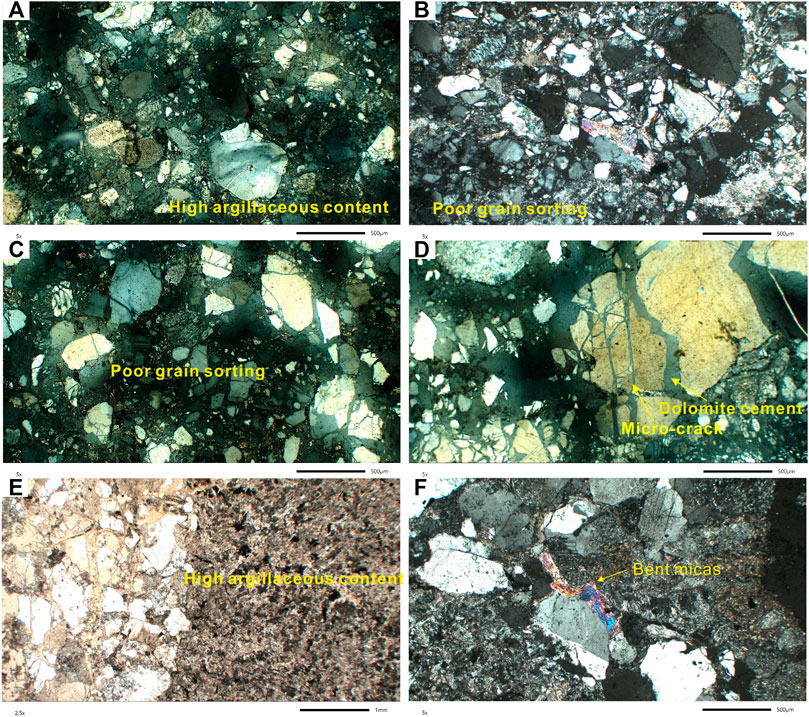
FIGURE 2. Diagenetic facies of strong compaction combined with alkaline cementation in the Es3 reservoir sandstones in well A-1. Note: (A) Orthogonal light, 2199 m, high argillaceous content; (B) orthogonal light, 2367 m, poor grain sorting; (C) orthogonal light, 2281 m, poor grain sorting, compaction-induced micro-cracks developing; (D) orthogonal light, 2253 m, compaction-induced micro-cracks developing and filled with dolomites; (E) transmission light, 2360 m, high argillaceous content; (F) orthogonal light, 2360 m, bent micas.
Diagenetic characteristics of the Es3 reservoirs in well A-2
Distribution of anomalously high porosity zone
Core samples were systematically collected from the reservoirs at a burial depth of 1100–2400 m in well A-2. Casting thin sections were prepared using the core samples, the pore types and plane porosity were tested, and accordingly, the porosity-depth evolution profile of the well was established (Figure 3). As indicated by this profile, a zone with anomalously high porosity exists at a burial depth of approximately 2000–2400 m in the Shahejie Formation reservoirs in well A-2, with a maximum porosity of 28%. The relationships of intergranular pores and secondary dissolution pores with the depth (Figure 3) show that the anomalously high porosity zone mainly results from both intergranular pores and secondary dissolution pores, with the former making more contributions. According to the XRD results, the illite/smectite mixed layers in mudstones corresponding to the anomalously high porosity zone have smectite content lower than 20% and thus are at the stage of superlattice ordered mixed layers. According to the Chinese petroleum industry standard SY/T5477-2003 The division of diagenetic stages in clastic rocks, the reservoirs at a burial depth of 1100–2400 m are at the middle diagenetic stage (A2).
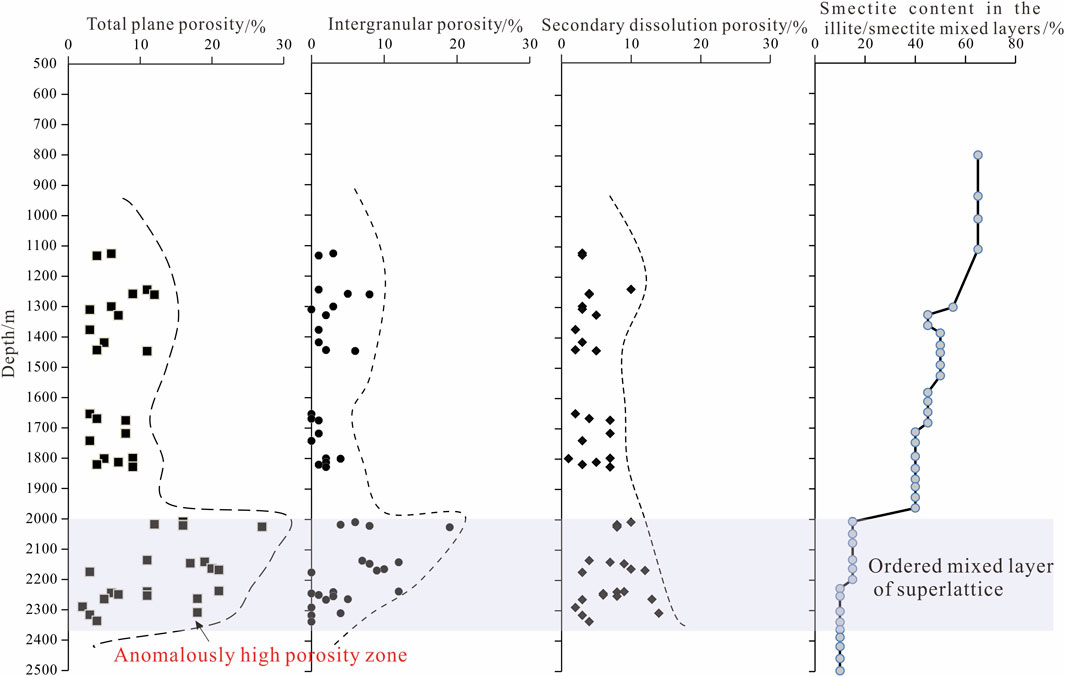
FIGURE 3. Plots of depth vs total plane porosity, intergranular porosity, secondary dissolution porosity, and smectite content in the illite/smectite mixed layers in well A-2.
Acid dissolution diagenetic facies
Specific typomorphic minerals and their genetic assemblages form by the changes in the acidity and alkalinity of aqueous media in the diagenetic environment. Therefore, they become important factors in determining the diagenetic environment (Wang et al., 2020). The casting thin sections show that the with anomalously high porosity zone at a burial depth of 2000–2400 m in well A-2 exhibit significant acid dissolution, which is typical of constructive diagenesis. The commonly visible dissolution includes the secondary pores by the dissolution of the feldspar grains or volcanic lithoclasts in the reservoir sandstones, as well as the dissolution of intergranular calcite cements. Among them, the intragranular dissolution pores of feldspars predominate (Figure 4A). Some feldspar grains have been dissolved completely, leaving behind moldic pores (Figure 4B), while some have only been partially dissolved along cleavage planes (Figure 4C). The lithic grains are mainly dissolved inward from the edges, generally forming a “bay” (Figure 4D). Secondary dissolution micropores of feldspar grains (Figure 4E) were also observed under a scanning electron microscope, with euhedral quartz and book-shaped kaolinite crystals frequently visible near the corroded feldspars (Figure 4F). The assemblage consisting of secondary dissolution pores, authigenic quartz, and kaolinite is typical acid dissolution diagenetic facies. With the inflow of acidic fluids and the feldspar dissolution, potassium ions flow away with the fluids, leaving the precipitation of authigenic quartz and authigenic kaolinite crystals (Zhang et al., 2017). These acidic fluids are likely the organic acids released from the evolution of organic matter in adjacent source rocks.
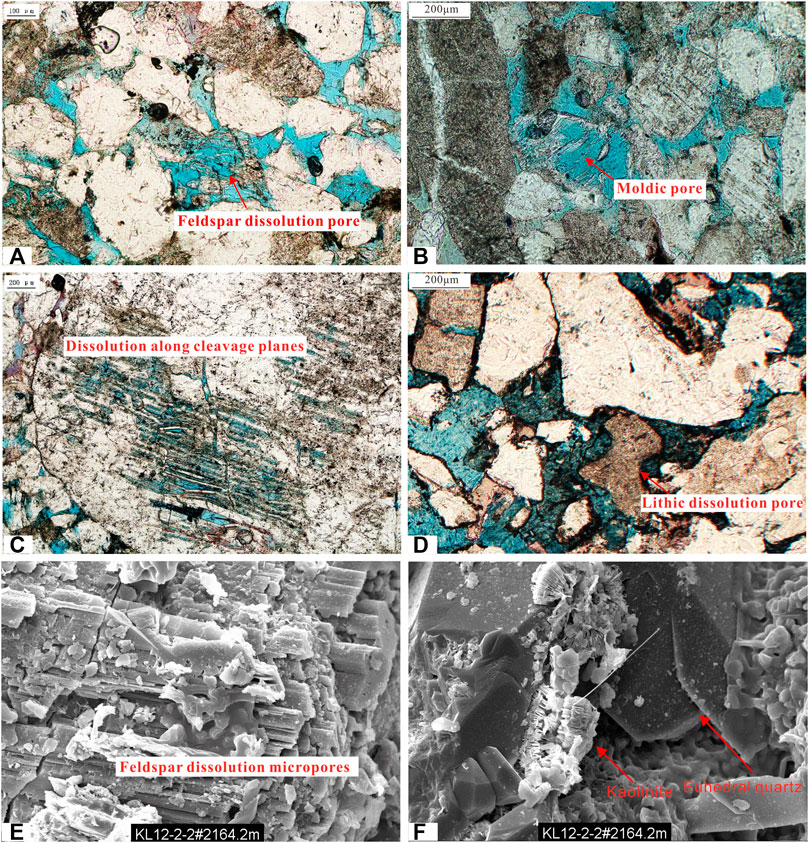
FIGURE 4. Acid dissolution diagenetic facies of the anomalously high porosity zone of the Es3 reservoirs in well A-2. Note: (A) Casting thin section, 2164.2 m, feldspar dissolution pores; (B) Casting thin section, 2168.4 m, moldic pores; (C) Casting thin section, 2147.5 m, feldspar dissolution along cleavage planes; (D) Casting thin section, 2168.4 m, lithic dissolution; (E) SEM, 2162.2 m, feldspar dissolution micropores; (F) SEM, 2162.2 m, book-shaped kaolinite and euhedral quartz.
At present, the content of the illite/smectite mixed layers shows that the anomalously high porosity zone is at the middle diagenetic stage (A2) and has entered the phase of organic acid release. The well A-1, located at the root of a fan delta, occur in the vicinity of fault zones. It is noteworthy that, the fault has long acted as a channel for the upward flow of deep alkaline fluids. However, the reservoirs of this well have not been altered by the acid fluids laterally expelled from multiple sets of source rocks due to the far distance.
Alkaline dissolution diagenetic facies
Quartz dissolution
Quartz grains in the anomalously high porosity zone were frequently dissolved by extensive alkaline fluids, many of which were dissolved into the shape of irregular sawteeth and bays (Figure 5A), significantly increasing the intergranular pores. Quartz grains are dissolved when the pH of pore water is greater than 9. In fact, quartz dissolution is common in many geological processes (Su et al., 2020), such as sponge activities, tectonic shear stress zones, and alkaline hydrothermal activities (Hippertt, 1994; Bavestrello et al., 1995). A significant feature of the study area is that clastic quartz grains are mainly dissolved by alkaline fluids, with no overgrowth boundary observed.
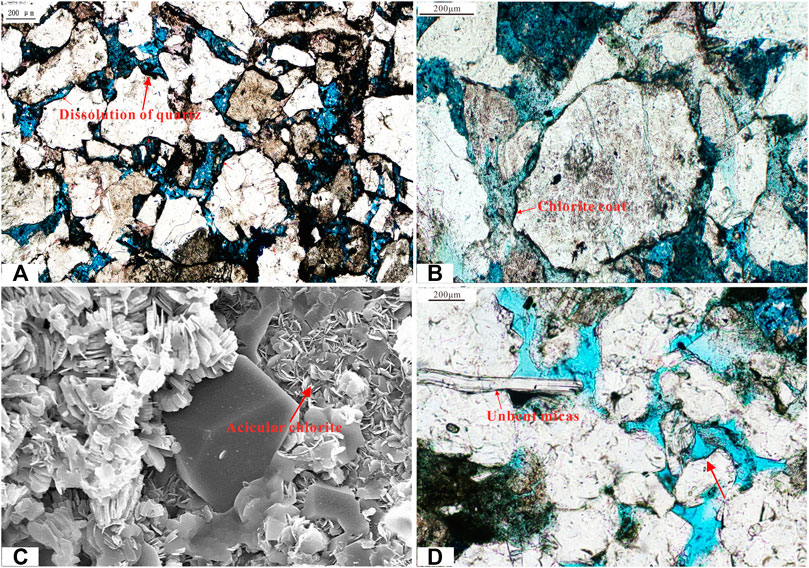
FIGURE 5. Alkaline dissolution of quartz grains, chlorite coats, and weak compaction in the anomalously high porosity zone of the Es3 reservoirs in well A-2. Note: (A) Casting thin section, 2174.5 m, dissolution of quartz grains; (B) casting thin section, 2174.5 m, a chlorite coat attached on the surface of dissolved quartz grains; (C) SEM, 2175 m, acicular chlorite; (D) casting thin section, 2273.5 m, unbent micas.
Chlorite coats
Another major feature of the anomalously high porosity zone is the well-developed authigenic chlorite coats, covering the outer edges of dissolved quartz grains (Figure 5B). The SEM observations show that acicular chlorites adhere to the grain surfaces (Figure 5C), suggesting that the quartz dissolution occurred earlier than or simultaneously with the growth of chlorite coats. As a special type of clay minerals, chlorites are rich in iron and magnesium and are typically deposited in alkaline environments. In the Es3 reservoirs of the study area, the detrital quartz grains are encapsulated in chlorite coats, without quartz overgrowth boundary. The secondary overgrowth of quartz grains in sandstones is considered controlled by thermal dynamics, and the quartz sedimentation rate generally starts to increase significantly at temperatures greater than 80–100°C (Lander et al., 2008). Accordingly, deep reservoirs are often cemented by siliceous materials, significantly increasing the likelihood of low porosity and permeability conditions. Based on the present geothermal gradient of the Laizhou Bay Sag, the geotemperature corresponding to the anomalously high porosity zone is above 80°C, which is within the onset temperature for the secondary overgrowth of quartz grains. Therefore, the absence of quartz overgrowth boundary in the study area is likely because the growth of chlorite coats inhibited the formation of quartz cements during the burial process. Consequently, the frequent contact between quartz grains and pore water has been restricted. This effect has been reported in many studies worldwide (Qu et al., 2015; Cao et al., 2022). In addition, the high-quality Es3 reservoirs in well A-2 have a burial depth of 2000–2400 m and are already in the stage of strong mechanical compaction. However, unbent micas were frequently observed on the casting thin sections (Figure 5D), indicating that chlorite coats may have resisted compaction to some extent. Authigenic chlorite content was detected in the mudstones near the high-quality Es3 reservoirs (Figure 6), indicating that the chlorite coats in the reservoirs may be a major contributor to the preservation of primary intergranular pores in the sandstones. The chlorites in the study area may be derived from the reactions of alkaline pore water rich in iron and magnesium with other minerals.
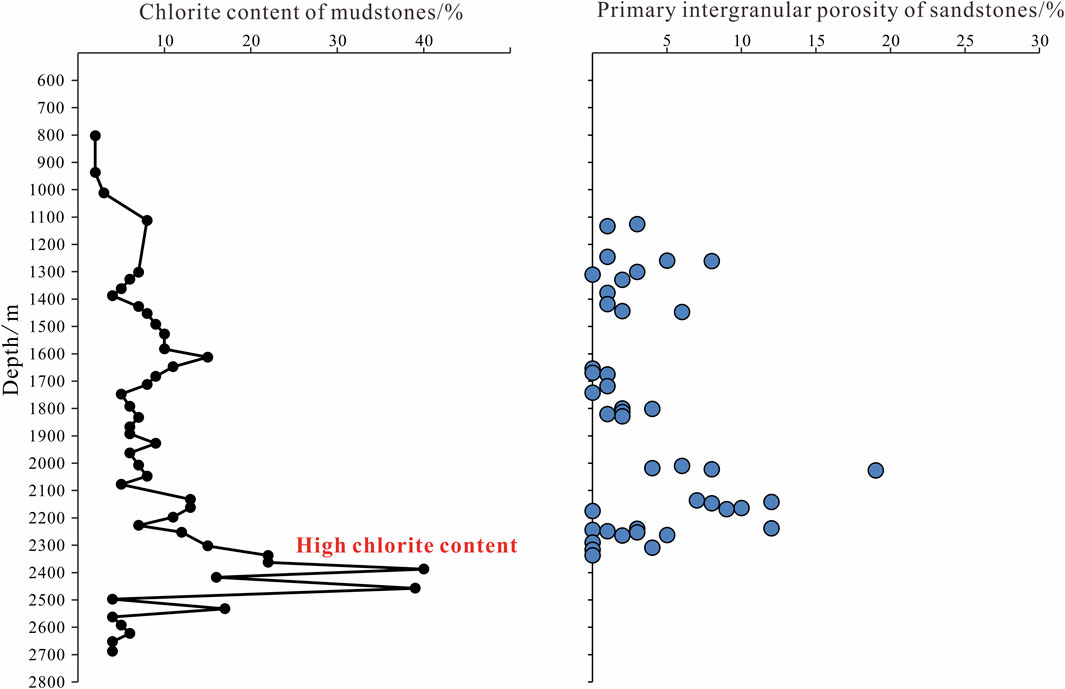
FIGURE 6. Profiles of depth vs chlorite content of mudstones and depth vs primary intergranular porosity of sandstones in well A-2.
Carbonate cementation
As shown by the casting thin sections stained with alizarin red, strong carbonate cementation has occurred at some depths in the high-quality reservoirs in well A-2. In addition, early calcite cements closely adhere to the grain surfaces of the grains coated with a chlorite film (Figure 7A), indicating that two episodes of alkaline fluid activities occurred and that the quartz dissolution and chlorite coats occurred after the sedimentation of early calcite. However, late acidic dissolution has created marks on the calcite cements. Moreover, a large number of intergranular and intragranular pores (e.g., the moldic pores of feldspars formed by acid dissolution) are filled by late dolomite cements (Figure 7B). These observations indicate that at least one episode of acidic fluid activity occurred in the reservoirs after the precipitation of early calcite, followed by another episode of alkaline fluid activity. We argue that the Fe and Mg ions needed for the sedimentation of ferrodolomites may be released during the conversion of clay minerals.

FIGURE 7. Carbonate cements in the anomalously high porosity zone of the Es3 reservoir sandstones in well A-2. Note: (A) Casting thin section, 2175 m, the secondary pores formed due to the dissolution of early filled calcite were filled with ferrodolomites; (B) casting thin section, 2175 m, the moldic pores of feldspars formed by acid dissolution were filled with ferrodolomites.
Alternating acid and alkaline diagenesis
As revealed by diagenetic observations of the high-quality reservoirs in the anomalously high porosity zone in the Es3 Member in well A-2, the reservoirs have undergone multiple episodes of alternating activities of acid and alkali fluids. Different types of diagenesis created both alkaline diagenetic facies (e.g., the dissolution of quartz grains, chlorite precipitation, and the cementation of calcite and ferrodolomite) and acidic diagenetic facies (e.g., the dissolution of feldspars and lithics, the precipitation of authigenic kaolinite and quartz, and the dissolution of calcite cements). The Es3 reservoirs underwent the superposition of these multiple episodes of diagenesis, forming the high porosity zone. Based on the contact relationships between various mineral assemblages in the reservoirs, the diagenetic sequence of the Es3 reservoirs in well A-2 can be qualitatively established. The alternating acid and alkaline dissolution processes of the high-quality reservoirs are as follows (Figure 8).
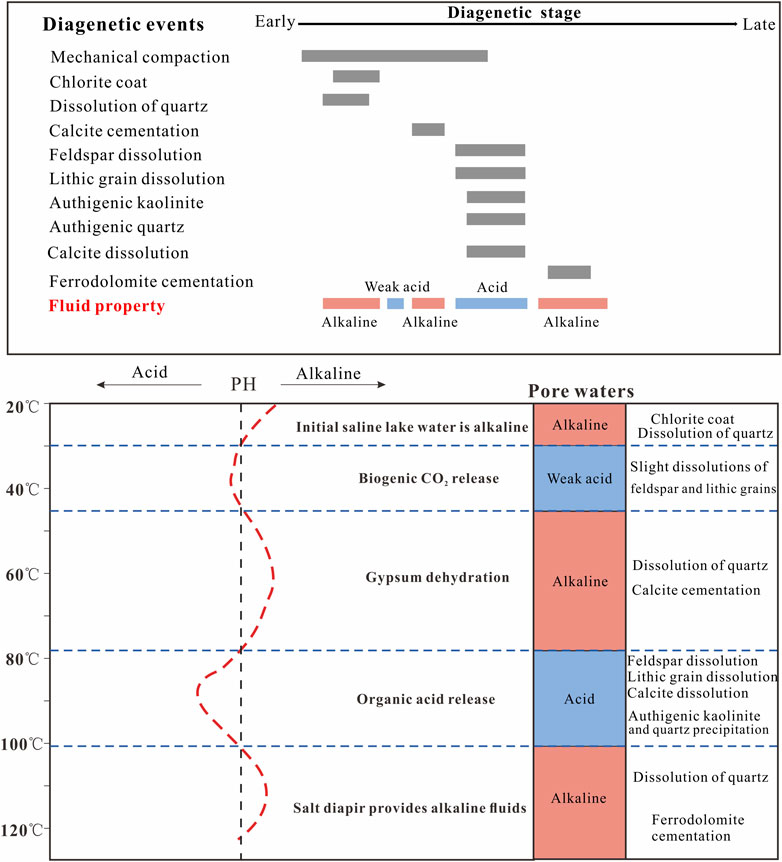
FIGURE 8. Diagenetic sequence and diagenetic fluid evolution in the anomalously high porosity zone of the Es3 reservoirs in well A-2.
First, the earliest episode of alkaline fluids (likely weak alkaline pore waters) in the Es3 reservoirs in well A-2 caused the dissolution of quartz grains, which was possibly accompanied by the growth of chlorite coats. Previous studies have shown that salt lakes mainly developed during the deposition of the Es4 Member in the Bohai Bay Basin and that the lake water gradually became less saline during the deposition of the Es3 Member. Therefore, it is likely that the connate saline sedimentary water was discharged from the underlying Es4 Member under compaction and entered the Es3 reservoirs along faults. Subsequently, the pH of pore water gradually decreased as alkaline dissolution proceeded. Meanwhile, as the second episode of slightly acidic fluids, CO2 formed by the biodegradation of organic matter in nearby source rocks under increased burial temperature entered the Es3 reservoirs. As a result, the alkaline dissolution of quartz ceased, and the pore waters gradually became slightly acidic. Afterward, the third episode of alkaline fluids flowed into the Es3 reservoirs, resulting in extensive calcite intercrystalline cementation. These alkaline fluids are probably related to the large-scale dehydration (starting at approximately 45°C) of the gypsum deposited in the Es4 Member at the early diagenetic stage, i.e., CaSO4·2H2O → CaSO4·1/2H2O+3/2H2O. With an increase in the burial, organic matter gradually matured and released large quantities of organic acid fluids. The fourth episode of acid fluids caused the massive dissolution of the early calcite cements originally precipitated in the reservoirs, creating a large number of secondary dissolution pores. Meanwhile, authigenic kaolinite and quartz precipitated. During the deposition of the Neogene Guantao and Minghuazhen formations, the salt diapir activities were triggered by the activity of the Tanlu strike-slip fault zones. The upwelling alkaline waters, representing the last episode of alkaline fluids, entered the reservoirs and caused the precipitation of ferrodolomite cements, leading to the reduction of reservoir physical properties to a certain extent.
For the Es3 reservoirs in well A-2, the multiple episodes of alternating dissolution of acid and alkali fluids have different effects on the formation of the high-quality reservoirs. The first episode of alkaline fluids, represented by the connate saline sedimentary waters, is the most critical to the formation of the high-quality reservoirs. This is because the early alkaline fluids dissolved numerous detrital quartz grains. More importantly, chlorite coats were formed during the early diagenetic stage, effectively impeding the subsequent secondary overgrowth of quartz and resisting the compaction to some extent. Therefore, the chlorite coats protected the primary intergranular pores, which is evident from the relationship between porosity and depth. The second episode of slightly acidic fluids containing biodegradable CO2 has limited effects on the anomalously high porosity zone due to the limited amount of CO2 produced from the organic matter biodegradation. The third episode of alkaline fluids formed by the large-scale dehydration of gypsum led to massive calcite cementation, which severely blocked pores. Nevertheless, the calcite cementation actively maintained the pores for the formation of the high-quality reservoirs because the early calcite cements not only inhibited the reservoir compaction but also provided a material basis for the late dissolution of organic acids. The fourth episode of organic acid fluids, leading to the dissolution of minerals such as calcites and feldspars, caused a significant and favorable alteration. The last episode of large-scale alkaline fluids, which originated from the salt diapirism induced by late strike-slip faulting, caused massive ferrodolomite cementation in the reservoir and thus reduced the physical properties of the reservoirs.
With high mud content and poor sorting property, the Es3 reservoirs in well A-1 drilled at the root of a fan delta have poor congenital physical properties. Moreover, carbonate cementation occurred in the reservoirs in well A-1 under the long-term action of alkaline fluids, causing the reservoirs to be tighter. Compared with the reservoirs in well A-2 drilled at the central portion of a fan delta, the reservoirs at well A-1 are far away from source rocks and lack access to the acidic fluids. This is likely an important reason for the present-day low porosity.
Conclusions
(1) The Es3 reservoirs in well A-1 drilled in the root of a fan delta in the Laizhou Bay Sag have poor physical properties and no hydrocarbon shows. The Es3 reservoir sandstones in well A-1 have high argillaceous content, are poorly sorted, and underwent strong compaction. Moreover, massive ferrodolomite cementation occurred under the long-term activities of alkaline fluids. In addition, owing to the far lateral distance from source rocks, the Es3 reservoirs could not effectively communicate with the organic acid fluids and, thus, lacked access to the acid dissolution.
(2) An anomalously high porosity zone has developed at a burial depth of 2000–2400 m in the Es3 member of well A-2. The high-quality reservoirs underwent the diagenesis of five episodes of alternating acid and alkali fluids. The first episode of alkaline fluids originated from the connate saline pore waters from the underlying Es4 member due to compaction. These fluids are critical to the formation of high-quality reservoirs and caused the dissolution of quartz grains and precipitation of chlorite coats on the outer edges of the quartz which impeded the overgrowth. The second episode of slightly acid fluids were derived from CO2 formed by the biodegradation of organic matter and had limited effects on the reservoirs. The third episode of alkaline fluids from the dehydration of Es4 gypsum, leading to massive calcite cementation and thus resisting compaction. The fourth episode of organic acid fluids released from the lateral source rock caused the acid dissolution, greatly favoring the physical properties. The last episode of alkaline fluids from the salt diapirs associated with strike-slip fault activity led to the blockage of partial pores by ferrodolomites, lowering the reservoir physical properties.
Data availability statement
The original contributions presented in the study are included in the article/Supplementary Material, further inquiries can be directed to the corresponding author.
Author contributions
HY is responsible for the idea and writing of this paper and SZ, AS, DG, YW, and WS are responsible for the data interpretation.
Funding
This research was funded by the National Natural Science Foundation of China (NO. 41472098).
Conflict of interest
Authors HY, DG, and WS were employed by the Tianjin Branch of CNOOC (China).
The remaining authors declare that the research was conducted in the absence of any commercial or financial relationships that could be construed as a potential conflict of interest.
Publisher’s note
All claims expressed in this article are solely those of the authors and do not necessarily represent those of their affiliated organizations, or those of the publisher, the editors and the reviewers. Any product that may be evaluated in this article, or claim that may be made by its manufacturer, is not guaranteed or endorsed by the publisher.
References
Anna, B., Susanne, G., and Peter, K. (2009). Porosity-preserving chlorite cements in shallow-marine volcaniclastic sandstones: Evidence from Cretaceous sandstones of the Sawan gas field, Pakistan. Am. Assoc. Pet. Geol. Bull. 93 (5), 595–615. doi:10.1306/01300908096
Bavestrello, G., Arillo, A., Benatti, U., Cerrano, C., Cattaneo-Vietti, R., Cortesognoi, L., et al. (1995). Quartz dissolution by the sponge Chondrosia reniformis (Porifera, Demospongiae). Nature 378 (6555), 374–376. doi:10.1038/378374a0
Bloch, S., Lander, R. H., and Bonnell, L. (2002). Anomalously high porosity and permeability in deeply buried sandstone reservoirs: Origin and predictability. AAPG Bull. 86 (2), 301. doi:10.1306/61EEDABC-173E-11D7-8645000102C1865D
Cao, Y. C., Yuan, G. H., Yang, H. J., et al. (2022). Current situation of oil and gas exploration and research progress of the origin of high-quality reservoirs in deep-ultra-deep clastic reservoirs of petroliferous basins. Acta Pet. Sin. 43 (01), 112. doi:10.11867/j.issn.1001-8166.2016.07.0718
Chen, Y., Zhang, Y., Zhu, Z. J., et al. (2019). Early sedimentary sequence and petroleum geological significance of faulted basins: A case study on the lower Es4 in bonan sag, jiyang depression. China Pet. Explor. 4 (3), 313–322. doi:10.3969/j.issn.1672-7703.2019.03.004
Ehrenberg, S. N. (1993). Preservation of anomalous high porosity in deeply buried sandstones by grain-coating chlorite: Examples from the Norwegian continental shelf. AAPG Bull. 77 (7), 1260.
Hippertt, J. F. (1994). Microstructures and c-axis fabrics indicative of quartz dissolution in sheared quartzites and phyllonites. Tectonophysics 229 (3-4), 141–163. doi:10.1016/0040-1951(94)90026-4
Jiang, W., Zhang, P., Li, D., Li, Z., Wang, J., Duan, Y., et al. (2022). Reservoir characteristics and gas production potential of deep coalbed methane: Insights from the no. 15 coal seam in shouyang block, Qinshui Basin, China. Unconv. Resour. 2, 12–20. doi:10.1016/j.uncres.2022.06.001
Katz, B., Gao, L., Little, J., and Zhao, Y. R. (2021). Geology still matters–Unconventional petroleum system disappointments and failures. Unconv. Resour. 1, 18–38. doi:10.1016/j.uncres.2021.12.001
Lander, R. H., Larese, R. E., and Bonnell, L. M. (2008). Toward more accurate quartz cement models: The importance of euhedral versus noneuhedral growth rates. Am. Assoc. Pet. Geol. Bull. 92 (11), 1537–1563. doi:10.1306/07160808037
Li, J. Y. (2017). Temporal-spatial evolution of diagenetic environment and diagenesis pore evolutionary process of red beds in the eastern Dongying Sag, Bohai Bay Basin. Oil Gas Geol. 38 (01), 90. doi:10.11743/ogg20170110
Longiaru, S. (1987). Visual comparators for estimating the degree of sorting from plane and thin section. J. Sediment. Res. 57 (4), 791–794. doi:10.1306/212f8c60-2b24-11d7-8648000102c1865d
Meng, T., Liu, P., Qiu, L. W., Wang, Y., Liu, Y., Lin, H., et al. (2017). formation and distribution of the high quality reservoirs in a deep saline lacustrine basin: A case study from the upper part of the 4th member of Paleogene Shahejie Formation in bonan sag, jiyang depression, Bohai Bay Basin, east China. Petroleum Explor. Dev. 44 (06), 948–959. doi:10.1016/s1876-3804(17)30107-6
Niu, C. M., Yang, H. F., Zhao, D. J., et al. (2022). Study on the ultra-late hydrocarbon accumulation and migration lagging effect in laizhouwan sag, Bohai sea. Editor. Comm. Earth Science-Journal China Univ. Geosciences 47 (02), 464. doi:10.3799/dqkx.2021.099
Peltonen, C., Marcussen, Ø., Bjørlykke, K., and Jahren, J. (2009). Clay mineral diagenesis and quartz cementation in mudstones: The effects of smectite to illite reaction on rock properties. Mar. Petroleum Geol. 26 (6), 887–898. doi:10.1016/j.marpetgeo.2008.01.021
Powers, M. C. (1953). A new roundness scale for sedimentary particles. J. Sediment. Res. 23 (2), 117.
Qu, X. Y., Liu, Z., Gao, Y., et al. (2015). The influence and formation environment of chlorite coatings in the clastic rock. Acta Sedimentol. Sin. 33 (04), 786. doi:10.14027/j.cnki.cjxb.2015.04.017
Su, A., Chen, H., Chen, X., He, C., Liu, H., Li, Q., et al. (2018a). The characteristics of low permeability reservoirs, gas origin, generation and charge in the central and Western Xihu depression, East China Sea Basin. J. Nat. Gas Sci. Eng. 53, 94–109. doi:10.1016/j.jngse.2018.01.034
Su, A., Chen, H., Chen, X., Liu, H., Liu, Y., and Lei, M. (2018b). New insight into origin, accumulation and escape of natural gas in the Songdong and Baodao regions in the eastern Qiongdongnan basin, South China Sea. J. Nat. Gas Sci. Eng. 52, 467–483. doi:10.1016/j.jngse.2018.01.026
Su, A., Chen, H., Yang, W., Feng, Y. X., Zhao, J. X., and Lei, M. (2021a). Hydrocarbon gas leakage from high-pressure system in the yanan sag, qiongdongnan basin, south China sea. Geol. J. 56 (10), 5094–5108. doi:10.1002/gj.4225
Su, A., Chen, H., Zhao, J. X., and Feng, Y. X. (2020). Integrated fluid inclusion analysis and petrography constraints on the petroleum system evolution of the central and southern Biyang Sag, Nanxiang Basin, Eastern China. Mar. Petroleum Geol. 118, 104437. doi:10.1016/j.marpetgeo.2020.104437
Su, A., Chen, H., Zhao, J. X., Feng, Y. X., and Nguyen, A. D. (2021b). Exhumation filling and paleo-pasteurization of the shallow petroleum system in the north slope of the biyang sag, nanxiang basin, China. Mar. Petroleum Geol. 133, 105267. doi:10.1016/j.marpetgeo.2021.105267
Surdam, R. C., Boese, S. W., and Crossey, L. J. (1984). The chemistry of secondary porosity. AAPG Mem. 37 (2), 127.
Vafaie, A., Kivi, I. R., Moallemi, S. A., and Habibnia, B. (2021). Permeability prediction in tight gas reservoirs based on pore structure characteristics: A case study from south western Iran. Unconv. Resour. 1, 9–17. doi:10.1016/j.uncres.2021.08.001
Volkmar, S., and Mc Donald, A. D. (1979). The role of secondary porosity in the course of sandstone diagenesis. Tulsa, Oklahoma: SEPM Society for Sedimentary Geology.
Wang, H., Zhou, S., Li, S., Zhao, M., and Zhu, T. (2022). Comprehensive characterization and evaluation of deep shales from Wufeng-Longmaxi Formation by LF-NMR technology. Unconv. Resour. 2, 1–11. doi:10.1016/j.uncres.2022.05.001
Wang, J., Cao, Y. C., and Gao, Y. J. (2013). Diagenetic characteristics and formation mechanism of Paleogene red-bed reservoirs in Dongying Sag. Acta Pet. Sin. 34 (02), 283. doi:10.7623/syxb201302010
Wang, J., Zhou, L., Liu, J., Zhang, X., Zhang, F., and Zhang, B. (2020). Acid-base alternation diagenesis and its influence on shale reservoirs in the permian lucaogou formation, jimusar sag, junggar basin, NW China. Petroleum Explor. Dev. 47 (05), 962–976. (In Chinese with English abstract). doi:10.1016/s1876-3804(20)60109-4
Xue, Y. G., Yang, H. F., Wang, H., et al. (2022). Discovery and significance of KL10-2 Neogene large oilfield in deep subsag zone of Laizhouwan sag, Bohai sea. China Offshore Oil Gas 34 (01), 17. doi:10.11935/j.issn.1673-1506.2022.01.003
Yang, H. F., Tu, X., Zhao, D. J., et al. (2021). Organic facies characteristics of source rocks on the 3rd and 4th member of Shahejie Formation in the southern laizhouwan depression, Bohai Bay Basin, China. J. Chengdu Univ. Technol. Sci. Technol. Ed. 48 (01), 72. doi:10.3969/j.issn.1671-9727.2021.01.08
Yuan, W. F., Chen, S. Y., and Zeng, C. M. (2005). Research development and prospects on Paleogene sea transgression in Bohai Bay Basin. Acta Sedimentol. Sinca (04), 604.
Keywords: acid-alkaline alternation, diagenetic fluids, chlorite coat, Laizhou Bay Sag, high quality reservoir
Citation: Yang H, Zhang S, Su A, Guan D, Wang Y and Su W (2023) Alternating acid and alkaline diagenesis in the Shahejie Formation of E12 structure in the Laizhou Bay Sag, Bohai Bay Basin. Front. Earth Sci. 10:1016973. doi: 10.3389/feart.2022.1016973
Received: 11 August 2022; Accepted: 15 September 2022;
Published: 05 January 2023.
Edited by:
Shuai Yin, Xi’an Shiyou University, ChinaReviewed by:
Bingshan Ma, Southwest Petroleum University, ChinaRonghu Zhang, PetroChina Hangzhou Research Institute of Geology, China
Copyright © 2023 Yang, Zhang, Su, Guan, Wang and Su. This is an open-access article distributed under the terms of the Creative Commons Attribution License (CC BY). The use, distribution or reproduction in other forums is permitted, provided the original author(s) and the copyright owner(s) are credited and that the original publication in this journal is cited, in accordance with accepted academic practice. No use, distribution or reproduction is permitted which does not comply with these terms.
*Correspondence: Shangfeng Zhang, anB1emhhbmdzZkAxNjMuY29t
 Haifeng Yang1
Haifeng Yang1 Ao Su
Ao Su